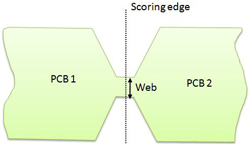PCB successfully added to your shopping cart
PCB Panels
Panelization is a must-have with the consideration of PCB manufacturing efficiency. On the one hand, panelization leads to the improvement of PCB manufacturing efficiency so that lead time can be greatly reduced. On the other hand, for small PCBs with irregular shapes, panelization is the most effective manufacturing way. For PCB assembly, panelization is crucial because it can downsize the cost of labor and it's convenient to control products' quality.
Owing to more than 10 years' experience in this field, PCBCart has been specializing in PCB panel fabrication and assembly. PCB panelization primarily comes in four forms: order panelization, rotation panelization, double-side panelization and combination panelization.
• Order panelization
Order panelization is the most massively-applied panelization method with its advantages:.
- a. Applicable for all circumstances
- b. Leading to the highest manufacturability
- c. Printing quality not influenced
- d. Fewest operating difficulties
• Rotation panelization
In order to reach the optimal utilization of board materials and decrease the waste of board space, panelization is implemented by rotating 90 or 180 degrees, which is called rotation panelization.
• Double-side panelization
Double-side panelization refers to the type of panelization in which both sides of a PCB are panelized on one side as a panel. Here're some advantages of double-side panelization:
- a. Increasing SMT overall efficiency
- b. Decreasing manufacturing cost
- c. Saving specimen curve material
- d. Quite suitable for mass manufacturing
• Combination panelization
Combination panelization, also called characteristic panelization, is a type of panelization in which different types of PCBs are combined together according to combination principles.
For more information about pros and cons of each type of panelization and their application fields, please refer to article The Surprising Secret to Designing Combination Method of PCB Panels.
Moreover, to conform to requirements of automated equipment, PCBCart has been striving to make PCB panel size in accordance with the manufacturing capabilities of automation equipment including paste printers, SPI equipment, SMT machines, reflow oven, AOI equipment and wave-solder machines.
V scoring
V scoring (AKA V-groove scoring) refers to V-shaped breaking lines connecting PCB boards for convenient separation, which is widely applied in PCB panels. The purpose of V scoring lies in its role in improving PCB assembly efficiency through decreasing the separation pressure between PCBs.
Depth and width of V scoring has to conform to corresponding rules. When it comes to the depth of V score, generally speaking, the whole depth should be cut equally, that is, one third cut on top and one third cut on the bottom while the rest one third is the connection part which is called web.

However, V scoring isn't applicable for boards with any degree of thickness. For PCBCart, we require that the thickness of PCB panels applying V scoring should be 0.6mm at least.
Width of V scoring is mainly determined by two elements: blade angle and blade wear. It is a common rule that the larger blade angle is, the wider V score will be and vice versa. PCBCart holds blades with angles of 30 degrees, 45 degrees and 60 degrees, catering to different assembly requirements of customers.






